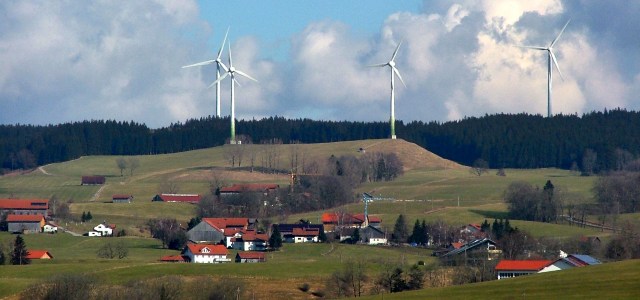Foreign observers sometimes think that the German feed-in tariff is a subsidy that comes out of the federal budget. In reality, it’s a levy that helps to raise revenue for communities and a model that should be copied, as R. Andreas Kraemer points out.

Renewable energies have been central to reinvigorating rural communities and raising revenues for city budgets in Germany. (Photo by Richard Mayer, CC BY 3.0)
The German feed-in tariff for renewable electricity is a revenue-raising instrument, not a subsidy. As part of the Energiewende suite of policies, it stimulates the development of renewable-energy industries for solar energy, wind power, biomass and bioenergy, and geothermal energy worth over 40 billion Euros in annual turnover, employing just under 400,000. The businesses and their employees pay taxes and social security contributions, earning the German federal government, the Länder (states) governments and municipalities billions in Euros annually in fiscal revenue. That is the opposite of what a subsidy does.
The feed-in tariff, or “FiT”, is financed through a levy on the electricity bills of households and small enterprises. It is not paid out of public budgets, nor does it diminish fiscal revenue. By its nature, the feed-in tariff is thus not a subsidy. It should be noted that large industrial users of electricity – if they are exposed to international competition – enjoy very large discounts on the levy. These reductions, constituting de-facto exemptions, may be considered subsidies. In its routine application of state-aid disciplines to ensure that no distortions in competition unduly disturb the functioning of the European Union‘s internal market, the European Commission found these reductions to be acceptable practice in the circumstances.
The FiT does stimulate and support the generation of renewable electricity as a commercial activity on German territory, carried out by businesses largely based or registered in Germany, with staff that for the most part lives and pays taxes in Germany. By stimulating domestic production and thus reducing the reliance of fossil fuel imports, the policy strengthens the balances of trade and payment. The increased fiscal revenue is a logical consequence of the growth of domestic value generation.
This simple set of facts is often denied by distractors of the Energiewende, either out of ignorance or in cynical misrepresentation of the German green power shift away from nuclear and fossil energy towards safe, clean, sustainable and cheaper renewable power. They may thus seek to present the Energiewende falsely as expensive, economically irresponsible and the outcome of an irrational “knee-jerk” policy response to the tragic nuclear catastrophe in Fukushima on 11 March 2011. Their purpose is to send the message that only a rich country like Germany could possibly afford such a policy, as they seek to stop the Gerrman Energiewende from inspiring other nations. It should be obvious to any neutral observer that feed-in tariffs in similar institutional settings would help those countries in the Eurozone that suffer from high deficits and debt.
R. Andreas Kraemer is the Founding Director & former CEO of Ecologic Institute who is currently on his sabbatical. This post was first published on his private blog as a comment to a letter by him and Paul Dorfman sent to the Financial Times. The letter explains why the German nuclear phase-out was an sensible decision and can be found on his website too.
I don’t think this is a very sensible way of looking at things.
Call it a levy if you wish, it is still a subsidy as in something that people are being required to pay and which they otherwise wouldn’t. Companies that receive direct subsidies still employ people, pay taxes and invest – so there is no difference from that point of view.
I think feed in tariffs have been a terrible idea and have held back progress with renewable energy, whilst at the same time interfering with rational development of renewable energy.
For instance, FiTs don’t address the issue of providing adequate storage – so development of storage e.g. pumped hydro has tended to lag behind. Meanwhile at times FiTs for domestic solar have threatened to destabilise the grid.
Far better to treat the development of a renewable energy system as something requiring a national investment programme – in the same way that the decision was taken in the UK to create a motorway network in the 1960s. To my mind this makes sense renewable energy requires a lot of up front capital investment (including in the grid) but operational costs are low.
The programme can mostly be funded through taxation (e.g. stamp duty or property taxes).
@Dan. FiTs have been a great tool to help renewable energy technologies through the learning curve. The spectacular cost decreases of photovoltaic solar energy is mostly to thank to the German FiT. However, it seems that policy makers never thought very hard about a smooth transition to a market based system.